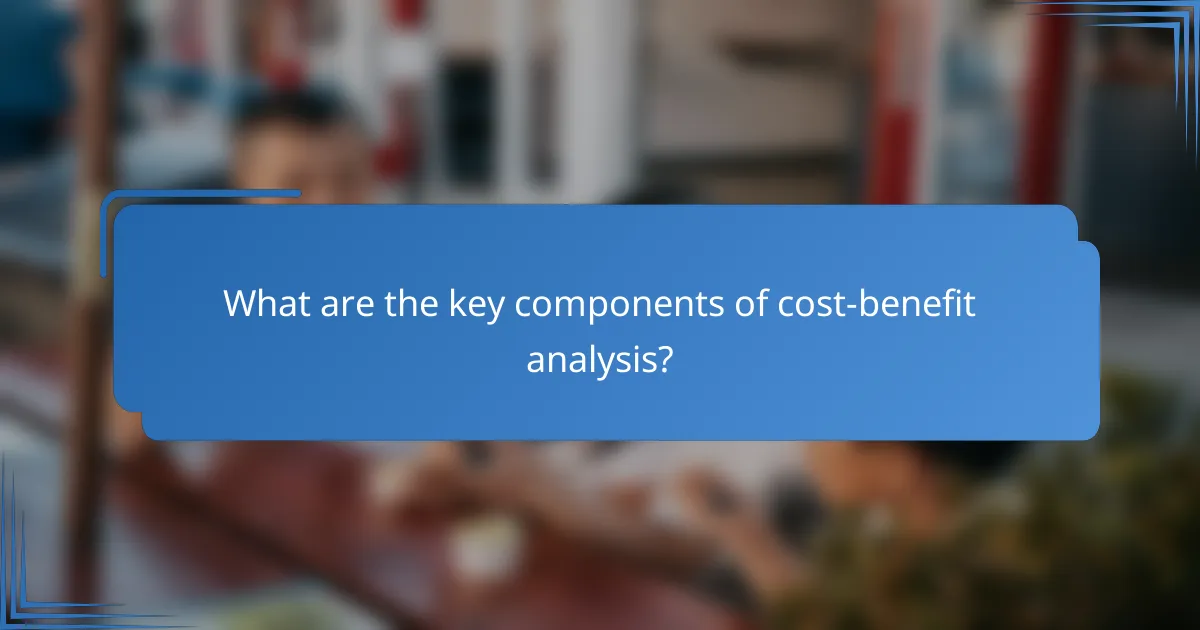Cost-benefit analysis (CBA) is a systematic approach used to evaluate the financial viability of projects by comparing expected costs with anticipated benefits. This analysis aids decision-makers in determining whether the potential returns justify the investment, ensuring that choices are informed and strategically sound. By examining both direct and indirect costs alongside tangible and intangible benefits, CBA provides a comprehensive framework for assessing the value of various options.

How to conduct a cost-benefit analysis in Australia?
Conducting a cost-benefit analysis in Australia involves systematically comparing the expected costs and benefits of a project to determine its viability. This process helps decision-makers assess whether the financial returns justify the investment and guides them in making informed choices.
Identify costs and benefits
Begin by listing all potential costs associated with the project, including direct expenses like materials and labor, as well as indirect costs such as overhead and opportunity costs. Next, identify the benefits, which may include increased revenue, improved efficiency, or enhanced customer satisfaction.
It’s essential to quantify these costs and benefits wherever possible. For instance, if a project is expected to generate additional revenue, estimate the range of that revenue based on market research or historical data. This will provide a clearer picture of the project’s financial implications.
Use financial modeling tools
Utilize financial modeling tools to analyze the data gathered from the costs and benefits. Common tools include spreadsheets for creating cash flow projections, net present value (NPV) calculations, and internal rate of return (IRR) assessments. These models help visualize the financial outcomes over time.
In Australia, consider using software that complies with local accounting standards. This ensures that your analysis aligns with regulatory requirements and provides accurate financial insights. Familiarity with these tools can significantly enhance the quality of your analysis.
Evaluate qualitative factors
While quantitative data is crucial, qualitative factors also play a significant role in a cost-benefit analysis. Assess aspects such as brand reputation, employee morale, and customer loyalty, which may not have direct monetary values but can impact long-term success.
Engage stakeholders to gather insights on these qualitative factors. Their perspectives can reveal potential risks or opportunities that numbers alone might overlook. Balancing quantitative and qualitative evaluations will lead to a more comprehensive understanding of the project’s overall impact.

What are the key components of cost-benefit analysis?
Cost-benefit analysis (CBA) involves comparing the costs of a project or decision against its expected benefits to determine its feasibility and value. The key components include identifying direct and indirect costs, as well as tangible and intangible benefits, which together inform decision-making.
Direct costs and indirect costs
Direct costs are expenses that can be directly attributed to a specific project or activity, such as materials, labor, and equipment. Indirect costs, on the other hand, are not directly linked to a single project but are necessary for overall operations, like administrative salaries or utilities.
When conducting a cost-benefit analysis, it’s crucial to accurately estimate both types of costs. For instance, if a company is considering a new software system, direct costs may include the purchase price and installation fees, while indirect costs could encompass training and ongoing support. Understanding these distinctions helps in making informed financial decisions.
Tangible and intangible benefits
Tangible benefits are measurable and quantifiable, such as increased revenue, reduced costs, or improved efficiency. Intangible benefits, however, are harder to quantify and may include factors like enhanced customer satisfaction, brand reputation, or employee morale.
In a cost-benefit analysis, it’s essential to consider both types of benefits. For example, while a marketing campaign may lead to a measurable increase in sales (tangible), it may also foster a stronger brand image (intangible). Weighing these benefits appropriately can significantly influence the overall assessment of a project’s value.

How to evaluate returns on investment?
Evaluating returns on investment (ROI) involves measuring the profitability of an investment relative to its cost. This process helps in making informed decisions by comparing potential returns against the expenses incurred.
Calculate net present value
Net present value (NPV) is a key metric that calculates the difference between the present value of cash inflows and outflows over a period. To compute NPV, discount future cash flows back to their present value using a specific discount rate, typically reflecting the cost of capital.
For example, if you expect to receive $10,000 in five years from an investment that costs $7,000 today, and your discount rate is 5%, the NPV can help determine if this investment is worthwhile. A positive NPV indicates that the investment is likely to be profitable.
Assess internal rate of return
The internal rate of return (IRR) is the discount rate at which the NPV of an investment equals zero. It represents the expected annualized return on an investment and is useful for comparing different investment opportunities.
To assess IRR, you can use financial calculators or spreadsheet software, which can automate the iterative process of finding the rate. A common rule of thumb is to consider investments with an IRR that exceeds your required rate of return, often set by your organization’s cost of capital.

What tools can assist in cost-benefit analysis?
Several tools can enhance the effectiveness of cost-benefit analysis by streamlining calculations and visualizing data. Utilizing software like Excel and Tableau can significantly improve the accuracy and clarity of your financial evaluations.
Excel for financial calculations
Excel is a powerful tool for performing financial calculations essential for cost-benefit analysis. It allows users to create detailed spreadsheets that can handle complex formulas, enabling quick calculations of costs, revenues, and net benefits.
When using Excel, consider leveraging built-in functions such as NPV (Net Present Value) and IRR (Internal Rate of Return) to assess the financial viability of projects. For example, inputting projected cash flows over several years can help determine whether an investment is worthwhile.
Be cautious of common pitfalls, like neglecting to account for inflation or using outdated data. Regularly updating your models and validating your assumptions can lead to more reliable outcomes.
Tableau for data visualization
Tableau excels in transforming raw data into interactive visualizations, making it easier to communicate the results of a cost-benefit analysis. With its drag-and-drop interface, users can create dashboards that highlight key metrics and trends.
Using Tableau, you can visualize costs versus benefits over time, helping stakeholders quickly grasp the implications of different scenarios. For instance, a line graph showing projected costs and benefits can clarify when an investment will break even.
To maximize Tableau’s effectiveness, ensure your data is clean and well-organized before importing it. Avoid cluttering visualizations with too much information; focus on the most relevant data points to enhance understanding.

What are common pitfalls in cost-benefit analysis?
Common pitfalls in cost-benefit analysis include overlooking hidden costs and ignoring long-term impacts. These mistakes can lead to skewed results and poor decision-making, ultimately affecting the success of projects or investments.
Overlooking hidden costs
Hidden costs are expenses that may not be immediately apparent but can significantly affect the overall financial picture. Examples include maintenance fees, training costs, and potential downtime. Failing to account for these can lead to an overly optimistic view of a project’s viability.
To avoid this pitfall, conduct a thorough review of all potential expenses associated with a project. Create a checklist that includes both direct and indirect costs, and consult with team members across departments to identify any overlooked factors.
Ignoring long-term impacts
Long-term impacts refer to the effects of a decision that extend beyond the initial investment period. These can include changes in market conditions, regulatory shifts, or evolving consumer preferences. Ignoring these factors can result in decisions that are beneficial in the short term but detrimental in the long run.
To effectively evaluate long-term impacts, consider using scenario analysis to project various future outcomes based on different assumptions. This approach can help identify potential risks and benefits over time, ensuring a more comprehensive understanding of the project’s implications.

How to present cost-benefit analysis results?
Presenting cost-benefit analysis results effectively involves clear communication of the findings and implications. Use visual aids and concise summaries to ensure stakeholders grasp the essential information quickly.
Use clear visual aids
Visual aids such as charts, graphs, and tables can significantly enhance the understanding of cost-benefit analysis results. For instance, a bar graph comparing costs and benefits side by side allows viewers to quickly assess the trade-offs involved.
When creating visual aids, ensure they are simple and directly related to the data presented. Avoid clutter and focus on key metrics, such as total costs, expected returns, and net benefits. This clarity helps stakeholders make informed decisions based on the analysis.
Summarize key findings
Summarizing key findings is crucial for effective communication of a cost-benefit analysis. Start with a brief overview of the total costs and benefits, highlighting the net gain or loss. For example, if the analysis shows a benefit-cost ratio of 2:1, emphasize that the project returns twice the investment.
Additionally, consider outlining the assumptions made during the analysis and any potential risks. This transparency helps stakeholders understand the context and reliability of the findings, leading to more informed decision-making.
